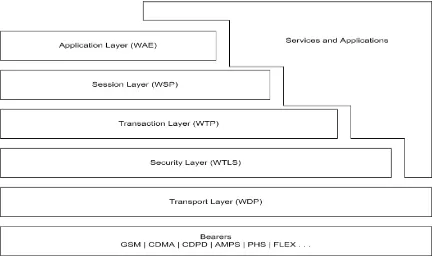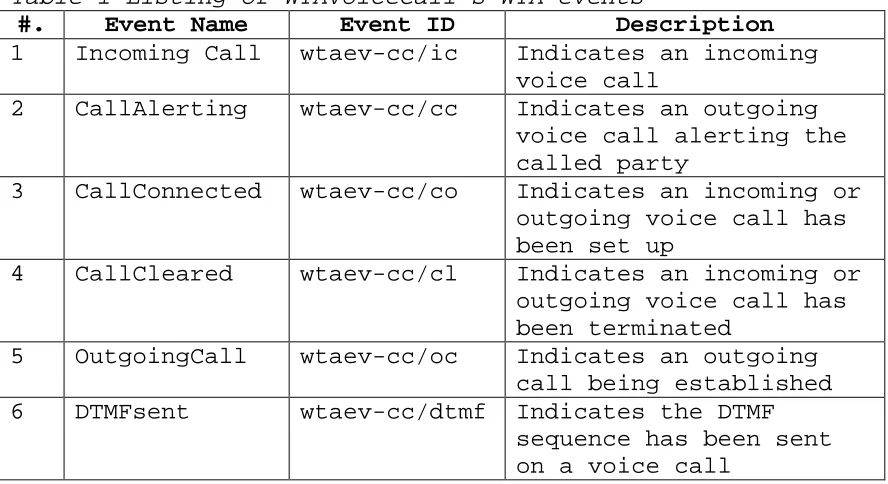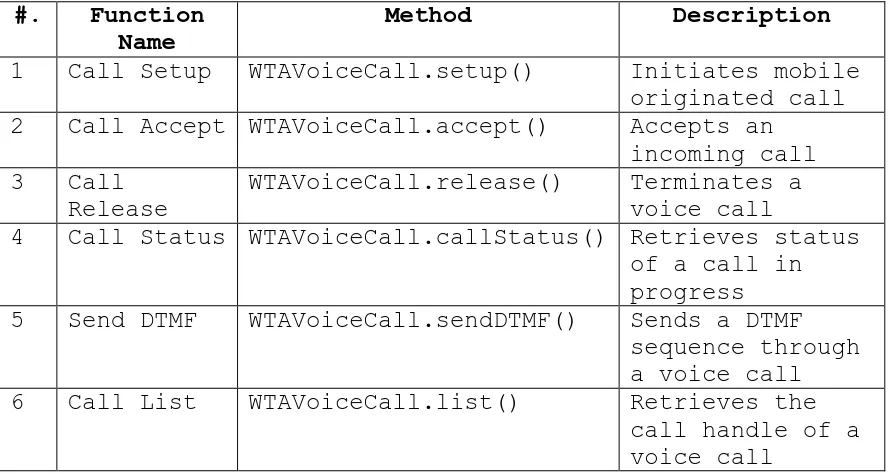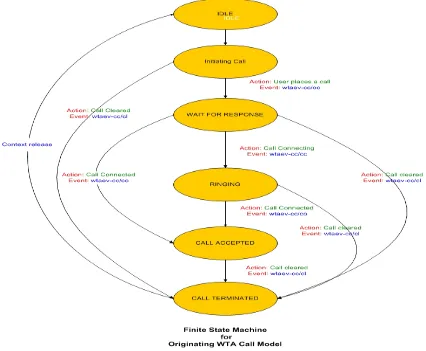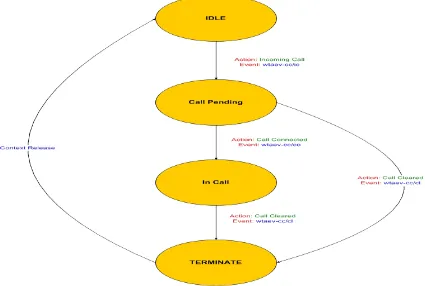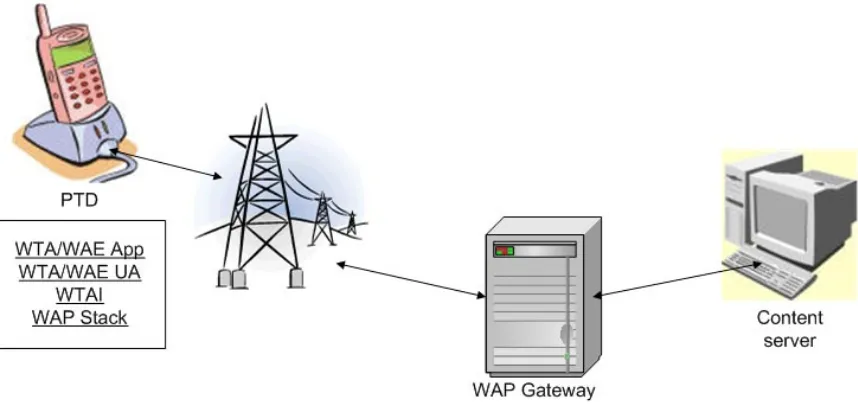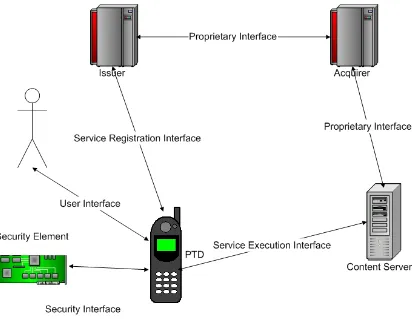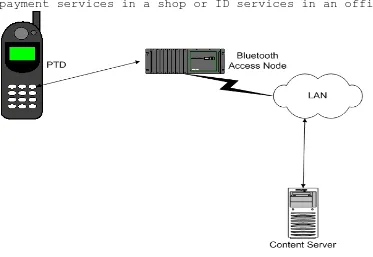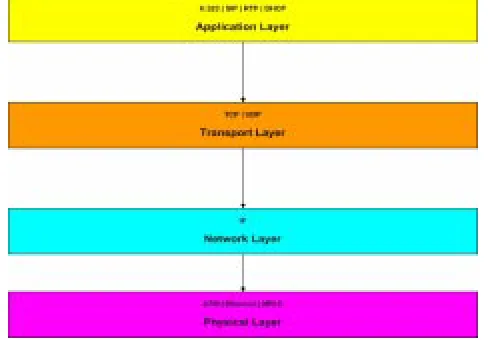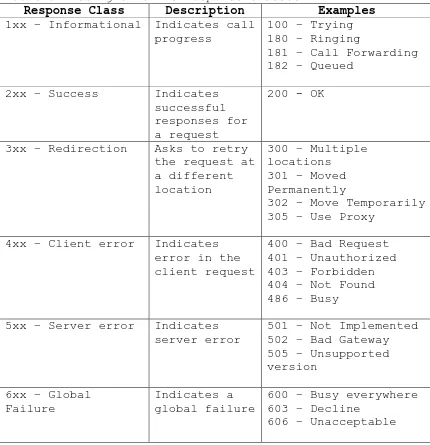Transaction. (Under the direction of Dr Arne Nilsson)
WAP and SIP are two different technologies to provide telephone services at present. Both technologies employ different approaches to establish connection, transmit data and terminate connection.
Biography
Prabhas Sinha is a research assistant and a master's student in the Department of Electrical & Computer Engineering at North Carolina State University in Raleigh, USA. He graduated with a BS degree in Electronics and Communication from Regional Engineering College (REC), Jaipur, India in June 1995. From 1995 to 2000, he worked for companies like LEC Denmark, HCL Perot Systems in UK & India and Motorola in India, primarily into object oriented software development & consulting. His main area of interests includes distributed object computing, object oriented design, design patterns and application frameworks and his current research interests focuses on wireless, SIP, WAP, 3GPP related topics.
Acknowledgements
First and foremost, I would like to thank my advisor Professor Dr Arne Nilsson for providing me with an opportunity to work on this thesis under his able guidance, providing me with all the resources, for his support, patience, constant encouragement and his confidence in me. I extend my sincere thanks to Vijay Gurbani of Wireless Networks Group/Internet Software and Services at Lucent Technologies, Naperville, Illinois for spending his valuable time in reviewing my work and giving lots of timely feedback. I would also like to extend my sincere gratitude to Dr Edward Gehringer who has put up with me for such a long time and have encouraged me every time during my stay at North Carolina State University. I also express my thankfulness to Dr Peng Ning for agreeing to be on the committee.
Words would seem superfluous if I take it to express my love and thankfulness to my parents for their unconditional love, guidance and continual encouragement since my childhood. I thank them for everything they have done for me. Last but not the least, I would also like to thank my friends who made my stint at NC State more enjoyable. My sincere thanks to Vijay Iyer, Girish Kulkarni, Sandeep
Table of Contents
Acronyms ……… v
List of Tables ……… vi
List of Figures ……… vii
1. Introduction ……… 1
2. Wireless Application Protocol 2.1 Layered Architecture of WAP ……… 3
2.2 Wireless Telephony Application Services …… 4
3. Mobile electronic Transaction 3.1 Service Interfaces ……… 10
3.2 Key Elements ……… 10
3.3 Operating Environments ……… 11
3.4 MeT Core Functions ……… 13
4. Understanding Session Initiation Protocol 4.1 TCP/IP Suite ……… 14
4.2 SIP 4.2.1 SIP Entities ……… 16
4.2.2 SIP Requests ……… 17
4.2.3 SIP sub-protocols ……… 17
4.2.4 SIP Responses ……… 18
4.2.5 Session Description Protocol ………. 19
4.2.6 SIP Headers ……… 20
5. Proposing the framework for SIP signaling in MeT 5.1 3GPP requirements on SIP ……… 22
5.2 Identification of SIP messages in MeT ………… 25
5.3 Support from WAP ……… 27
5.4 Service Broker ……… 29
5.5 Mapping SIP messages to WTA Event Model 5.5.1 Originating WTA event model ……… 32
5.5.2 Terminating WTA event model ……… 34
5.5.3 Call Flow ……… 36
5.6 Defining SIP/WTA extensions ………. 36
6. Conclusions ……… 37
Acronyms
API : Application Programming Interface ASB : Application Service Broker
CSCF : Call Session Control Function DNS : Domain Naming Service
DTMF : Dual Tone Multi-Frequency
GSM : Global System for Mobile Communications HSS : Home Subscriber Server
HTTP : Hyper Text Transport Protocol I-CSCF: Interrogating-CSCF
IMS : IP Multimedia System IP : Internet Protocol PAP : Push Access Protocol P-CSCF: Proxy-CSCF
PTD : Personal Trusted Device S-CSCF: Serving-CSCF
SDP : Session Description Protocol SIP : Session Initiation Protocol SMTP : Simple Mail Transport Protocol MeT : Mobile Electronic Transaction TCP : Transport Control Protocol TLS : Transaction Layer Security
UA : User Agent
UAC : User Agent Client UAS : User Agent Server
UDP : User Datagram Protocol
URI : Uniform Resource Identifier URL : Uniform Resource Locator
WAE : Wireless Application Environment WAP : Wireless Application Protocol WSP : Wireless Session Protocol WTP : Wireless Transport Protocol
WTLS : Wireless Transaction Layer Security WDP : Wireless Datagram Protocol
WTA : Wireless Telephony Applications
WTAI : Wireless Telephony Applications Interface WWW : World Wide Web
List of Tables
Table 1 Listing of WTAVoiceCall’s WTA events ……… 5
Table 2 Listing of WTAVoiceCall’s functions ……… 6
Table 3 Listing of SIP’s response classes ……… 19
Table 4 Listing of SDP’s attributes ……… 20
List of Figures
Figure 1 WAP Stack Layer ……… 3
Figure 2 Originating Call Model ……… 7
Figure 3 Terminating Call Model ……… 8
Figure 4 WTA Application end-to-end systems ……… 9
Figure 5 MeT Reference Model ……… 11
Figure 6 MeT in local environment ……… 12
Figure 7 MeT in personal environment ……… 12
Figure 8 TCP/IP Protocol Stack ……… 14
Figure 9 Registration in IMS Subsystem ……… 23
Figure 10 Invitation in IMS Subsystem ……… 24
Figure 11 WAP 2.0 Stack ……… 27
Figure 12 Reference model for SIP signaling in WAP … 28 Figure 13 Application Services Platform ……… 30
Figure 14 Application Services Broker ……… 31
Figure 15 Mapping between O_WTA state machine and SIP state machine ……… 32
Figure 16 Mapping between SIP state machine and T_WTA state machine ……… 34
1.Introduction
SIP (Session Initiation Protocol) is being used for IP telephony and a great deal of work has been taken up by IETF, ITU and ETSI because it is completely integrated with other Internet and web protocols. SIP is a text-based,
lightweight, application layer signaling protocol for multimedia call control. SIP is expected to fundamentally change networking services and the communication habits of the billions of users worldwide in the coming years, with ramifications for the business models of firms in the
entertainment, e-commerce and M-commerce industries, in the areas of broadband services, wireless, enterprise
applications, network appliances and overlay SIP services. One of these communication services, which will derive immense interoperability with SIP, is MeT (Mobile
Electronic Transaction). The advent of wireless telephony, its unprecedented success and millions of PTDs (Personal Trusted Devices) to be marketed in the time to come implies that a huge number of users worldwide will be a party to mobile e-business. MeT will foster a massive growth in mobile e-business arena and we foresee that MeT and SIP will come together and augment their coherent growth across multiple access technologies and seamlessly evolving
scenarios. There could be numerous M-commerce applications that would need a session to be established, multimedia transport, and presence etc. where SIP fits very well. This is a Master’s thesis work done at the Department of Electrical & Computer Engineering, North Carolina State University in Raleigh, USA towards the fulfillment of the award of Master’s degree. The objective of this thesis work is to study SIP, WAP & MeT, understand how these
technologies work and propose a framework in which they can interoperate. As these technologies get deployed and
and WAP protocols3GPP work on SIP is focused more on telephony applications but doesn’t talk about other applications. An effort to converge SIP-WAP protocols will facilitate more benefits to the end users. As a end user one would like to have one wireless device with all applications on it, be it telephony or banking or messaging services or web browsing or
2. Wireless Application protocol
Wireless Application Protocol, as the name suggests is a technology that assists in developing applications for wireless devices in order to enable them to access internet, telephony services and even intranet. WAP’s
architecture is based on the existing OSI model but it does not use all of the layers and instead has defined its own set of protocol layers that are lightweight. The following are some of the constraints of wireless environment:
Low bandwidth High Latency
Less connection stability
Hence WAP layers have been optimized to meet these requirements.
also allows effective bridging between WAP and the Internet by making use of protocol converters, gateways, proxies and service brokers within the network infrastructure. Layering makes it possible for each layer to provide an interface directly to applications and services in addition to exposing an interface to the layer above it. This means that if an application wants to interact directly with datagram transport layer (WDP) for their services, it can do so. Conceptually these layers can be divided into three groups:
Bearer Layers: encapsulates the various signaling and channel protocols for wireless networks
Service Layers: encapsulates protocols which are primarily responsible for data transmission across the wireless
network
Application Layers: microbrowser embedded in every wireless device that forms the user interface
Discussion of Bearer Layer is out of the scope of this thesis but lets look into the Service Layer, which essentially contains the WAP Stack protocols:
1. Session Layer: WSP establishes session between the mobile device and the WAP gateway and also allows handshake between applications for data exchange.
2. Transaction Layer: WTP supports pairing between client requests and server responses. It provides transaction support and overcomes the unreliable feature of WDP. 3. Security Layer: WTLS provides encryption facilities
and enhances data security between wireless device and the WAP gateway.
4. Transport Layer: WDP forms the transport layer of WAP architecture and sends and receives datagram over the network. It is an unreliable protocol.
2.2 Wireless Telephony Application Services
Since this thesis focuses on mobile electronic transactions so lets look at the WAP Wireless Telephony Application
Interface. WTAI is a set of services to create telephony applications. These interfaces are part of WTAI functions libraries accessible via WMLScript. They can be classified as:
it will not be discussed here, as it does not go in line with this research.
Network-common services: The most common features available in all the networks accessible only through WTA user-agent. The WTA events in these services are related to voice
calls, network messages, phonebook, call logs and
miscellaneous. For this research, we are interested only in voice call control, which is served by the WTAVoiceCall library. The table below shows the various WTA events of WTAVoiceCall library.
Table 1 Listing of WTAVoiceCall’s WTA events
#. Event Name Event ID Description 1 Incoming Call wtaev-cc/ic Indicates an incoming
voice call
2 CallAlerting wtaev-cc/cc Indicates an outgoing voice call alerting the called party
3 CallConnected wtaev-cc/co Indicates an incoming or outgoing voice call has been set up
4 CallCleared wtaev-cc/cl Indicates an incoming or outgoing voice call has been terminated
5 OutgoingCall wtaev-cc/oc Indicates an outgoing call being established 6 DTMFsent wtaev-cc/dtmf Indicates the DTMF
sequence has been sent on a voice call
The table below shows the various functions of WTAVoiceCall library. All these functions are non-blocking and WTA
Table 2 Listing of WTAVoiceCall’s functions #. Function
Name
Method Description
1 Call Setup WTAVoiceCall.setup() Initiates mobile originated call 2 Call Accept WTAVoiceCall.accept() Accepts an
incoming call 3 Call
Release
WTAVoiceCall.release() Terminates a voice call
4 Call Status WTAVoiceCall.callStatus() Retrieves status of a call in progress 5 Send DTMF WTAVoiceCall.sendDTMF() Sends a DTMF
sequence through a voice call 6 Call List WTAVoiceCall.list() Retrieves the
call handle of a voice call
Network Specific services: specific features available in select networks or operators, which is beyond the scope of this thesis.
Thus Network-common WTA services can place calls, receive calls, terminate it and get information about voice calls. There is two call models: originating call model and
terminating call model.
The originating call model describes the protocol call states of an originating call from a mobile device. The
Figure 2 Originating Call Model
The terminating call model describes the protocol call states of an incoming call to a mobile device. The diagram below shows the terminating call model. It shows the various call states, actions by the user and the network events
Figure 3 Terminating Call Model
If the caller and called party belong to the same WAP gateway, the originating call model is assigned to the caller and the terminating call model is assigned to the called party. If the call get routed through multiple gateways to get to the destination, each of the
participating gateways will run both the call models, with the destination gateway’s terminating call model providing services to the called party.
WTA applications must generate WTA events as shown in the call models.
Figure 4 WTA Application end-to-end systems
3. Mobile Electronic Transaction
Mobile electronic Transaction, popularly known as MeT, is an initiative started by Ericsson, Motorola and Nokia to establish and promote a framework for secure mobile
transactions using a mobile device. Interoperable mobile transactions are the objective of this initiative. With WAP it has become possible to access mobile Internet services and execute mobile e-commerce transactions.
It has been predicted that mobile e-business will very soon become a substantial activity and it has been estimated that by the end of 2003 there will be more mobile devices than PCs connected to the Internet. The mobile phone is evolving into a Personal Trusted Device (PTD), which will not be just a wireless telephone but will have the capabilities to
support services and applications like banking, payments, ticketing and secure access-based operations. MeT
architecture describes how these applications can be accessed over the PTD in different environments.
3.1 Service Interfaces
MeT has defined three interfaces:
3.1.1 Service registration interface: This interface exists between the issuer and the PTD and it is primarily used for registering the PTD and loading the service certificates onto the PTD. The issuer may be a bank or a store’s credit department.
3.1.2 Service execution interface: This interface exists between the content server and the PTD and is used for executing secure transactions with the content server. 3.1.3 User interface: This interface basically represents the user interaction in a MeT transaction like presenting the transaction information to the user, getting the user input and accepting the same and passing it to the
transaction routines.
3.2 Key Elements
The MeT core specifications include key elements like a PTD: the user’s mobile phone
Content server: provides the transaction content
issuers and the content providers and controls the business rules applicable to a transaction.
Issuer: provides the service certificate for an account to identify the user.
This diagram shows the various key elements, interfaces and the reference model of MeT system.
Figure 5 MeT reference model
payment services in a shop or ID services in an office.
Figure 6 MeT in a local environment
3.3.3 Personal environment: possibly over Bluetooth to perform transaction in association with a PC.
3.4 MeT core functions
The core functions in a MeT transaction are as follows:
3.4.1 Initialization: equipping the security element with the initial private-public key pairs and root CA certificates or SIM/WIM cards necessary to execute secured MeT transaction initializes the PTD.
3.4.2 Registration: The PTD shall have a service account with a service provider so that it can be identified. Here a user service certificate is
associated with the service and assigned to its key pairs. Multiple service certificates from different service providers can be assigned to a common key pair. It is possible to combine initialization and registration functions.
3.4.3 Secure session establishment: confidentiality, data integrity and security of a transaction are very important to be established between the PTD and the content server. WTLS is used for it however WTLS
operates only between the PTD and the WAP gateway and then SSL or TLS is used between the WAP gateway and the content server. So it is not an end-to-end
security. Thus the WAP gateway must be secure and trusted.
3.4.4 Authentication: the service provider to
authenticate the PTD user uses it. However not all MeT services requires it. The WAP gateway establishes the identity of the user by means of the user service certificate assigned to the key pairs in the PTD. So the server challenges a PTD and the user enters the access PIN over the PTD to authenticate himself.
4. Understanding Session Initiation Protocol
SIP is a new signaling protocol which is being used for IP telephony and multimedia call control. It can establish, modify and terminate a multimedia session over the
Internet. SIP has received a lot of attention recently
because it is completely integrated with other Internet and web protocols. SIP derives its features from HTTP (Hyper Text Transport Protocol) used over the web and SMTP (Simple Mail Transport Protocol) used for e-mails. SIP also
interacts with other Internet Protocols like IP, TCP, UDP and DNS. The client-server paradigm and the use of URLs (Uniform Resource Locators) has been imbibed from HTTP
whereas text-encoding and header style like To, From, Date,
Subject etc. has been borrowed from SMTP. It is a
text-based, lightweight application layer signaling protocol. It makes use of the layered Internet Multimedia Protocol stack. These layers provide functions for communication processes. We are indeed referring to TCP/IP protocol suite here. SIP can use TCP as well as UDP for transport.
4.1 TCP/IP Suite
It consists of four layers as shown here:
Figure 8 TCP/IP Protocol stack
4.1.2 Network Layer: this is the Internet Layer and IP is used for packet routing across the network using the
destination IP addresses which are four octets long, also known as “dotted-decimal notation” (e.g., 152.161.1.11). IP is a connectionless protocol and provides best-effort
packet delivery.
4.1.3 Transport Layer: it verifies whether the network layer is working efficiently or not and employs two well-known protocols, namely TCP and UDP, to deliver the
datagram to correct applications using two-octet port number. Some port numbers are called “well-known” port
numbers like 80 for HTTP, 5060 for SIP, 5004 for RTP. Other applications are assigned port numbers from a pool of
available port numbers known as “ephemeral” port numbers that ranges between 49152-65535.
1. TCP
Transmission Control Protocol is a
connection-oriented, highly monitored reliable transport protocol over IP, which provides error-correction, and flow control. TCP uses sequence numbers and
acknowledgements to implement flow control and other services over IP.
2. UDP
SIP has the capabilities to implement reliability in
transporting SIP messages hence it can use unreliable UDP. If TCP is used then these mechanisms are not used.
4.2 SIP
SIP is a lightweight, text-based, application layer
signaling protocol for multimedia call control. It is used to create, modify and terminate sessions with one or more participants. These sessions include, but not limited to, Internet multimedia conferences, IP telephony etc.
Signaling is achieved based on entities like SIP clients and servers, well-defined SIP request messages, SIP
response messages, included SIP headers, related protocols like SDP, RTP etc.
4.2.1 SIP Entities
The following primary entities have been defined in RFC 2543:
User Agent Client (UAC): UAC is a SIP-enabled end-device that initiates a session. It maintains call states, which it initiates or participates in. Even if a session has been terminated, call state must be maintained by the UAC for at least 32 seconds to accept responses incase of lost
messages in the call termination.
User Agent Server (UAS): UAS is a SIP-enabled server
application that contacts a user when a request is received and responds on behalf of the user. It can accept, reject or redirect a request. UAS too maintains the call state as mentioned for the UAC.
Proxy, Proxy server: It is an intermediary entity that acts as both client and server. It can make requests on behalf of other clients and service a received request internally or by passing them to other proxies possibly after
translation. A proxy server has no media capabilities. It can either be a stateless server or a stateful server. A stateless server never stores any information about a message once it has been parsed, processed or responded. All the processing is done sheer based on the message contents. It never uses any timers nor retransmits a message. A stateful proxy server, on the contrary,
maintains information of all the requests and responses and uses it for future processing. It is capable of
used only to help the caller user agent to locate the called party (if they don’t know each other apriori) and once a connection is established then proxy does not participate in the call. The two parties can communicate directly.
Redirect server: It receives a SIP request and returns zero or more possible locations for the called party. No message forwarding is done. It neither initiates a request unlike the UAC nor accepts a call unlike the UAS.
Registrar: A registrar server accepts SIP REGISTER
requests. It can be co-located with a proxy server or a redirect server. It provides the information about the registered SIP user agents to other SIP servers within the same administrative domain. A user agent must register with the registrar if it intends to receive calls. Registration is not necessary for making outgoing calls.
4.2.2 SIP Requests
There are six defined methods:
INVITE: is used to set up multimedia sessions between two parties
REGISTER: is used by a user agent to register it with the registrar notifying it of its contact address where it can receive calls.
BYE: is used to terminate an established session and is always initiated by the participating user agents.
ACK: is used to acknowledge the final responses to INVITE methods. Other final responses are never acknowledged. OPTIONS: is used to find out the capabilities and
availability of a UA or a server. It is always initiated by a UA and never by a proxy.
CANCEL: is used to teardown a pending INVITE.
by sending a request to a multicast address
“sip.multicast.net” (224.0.1.75). Same UA can register from different locations. Third party registration is also
allowed. The requests are processed in the order they are received.
Session Invitation (3 Phase Protocol): To establish a
multimedia session with another UA for a two-party call or a multiparty conference. The UAC sends an INVITE request possibly with a message body in SDP format. The proxies can send 1xx informational response and the UAS sends the final responses (2xx - OK or non-2xx - reject). The 2xx response contains the media capability of the receiver. The UAC
sends an ACK to acknowledge this 2xx response. If a non-2xx response is generated then the first proxy that receives this response from the UAS sends an ACK to the UAS and forwards it to the caller. Caller on receipt sends an ACK that gets terminated at the first proxy.
Session Modification (3 Phase Protocol): To inform all the participants of a session about the change in parameters of an existing session possibly by sending a re-INVITE
request.
Session Termination (2 Phase Protocol): To terminate an established session by sending a BYE message. Either caller or the callee can initiate this request. The UA agent
receiving a BYE request must stop transmitting data.
Invite Request Cancellation (2 Phase Protocol): To cancel a pending request other than ACK and CANCEL e.g., REGISTER, INVITE, OPTION but typically it is used to cancel a pending INVITE request.
4.2.4 SIP Responses
Table 3 Listing of SIP’s response classes
Response Class Description Examples 1xx – Informational Indicates call
progress
100 – Trying 180 – Ringing
181 – Call Forwarding 182 – Queued
2xx – Success Indicates
successful responses for a request
200 - OK
3xx – Redirection Asks to retry the request at a different location
300 – Multiple locations
301 – Moved Permanently
302 – Move Temporarily 305 – Use Proxy
4xx – Client error Indicates error in the client request
400 – Bad Request 401 – Unauthorized 403 – Forbidden 404 – Not Found 486 – Busy
5xx – Server error Indicates server error
501 – Not Implemented 502 – Bad Gateway 505 – Unsupported version
6xx – Global Failure
Indicates a global failure
600 – Busy everywhere 603 – Decline
Table 4 Listing of SDP’s attributes
Field Description Mandatory ? Remarks
v SDP version Yes
o Session
originator
Yes Not used by SIP but
included for compatibility
s Subject Yes Not used by SIP but
included for compatibility
i Session Info No
u URI No
e Email id No
p Phone Number No
c Connection
Info
Yes Used by SIP to set up
sessions between UAs
b Bandwidth
Info
No
t Start & end time for session
Yes Not used by SIP but
included for compatibility
r Repetition No
z Timezone Info No
k Encryption
Key
No
a Attribute No Used by SIP to set up
sessions between UAs
m Media Info Yes Used by SIP to set up
sessions between UAs
4.2.6 SIP Headers
Table 5 Listing of SIP’s Headers
Header Type Description Associated Headers
General Includes all the
mandatory headers in a SIP message (request as well as response). In most of the cases these headers are
generated by the UA and can not be
modified by proxies
Call-ID Contact Content-Encoding Content-Length Content-Type Encryption From To Subject Via Cseq etc. Request Usually inserted by
a UAC in a SIP message to give additional information about the request Accept Accept-Contact Accept-Encoding Accept-Language Authorization Record-Route Max-Forwards Session-Expires Response-Key etc. Response Usually inserted by
a UAS or server in any response to give additional information about the response Unsupported Server Proxy-Authenticate Warning WWW-Authenticate Rseq etc.
Entity Used to provide
5. Proposing the framework for SIP Signaling in MeT
The key to this framework is to derive conceivable
messaging interoperability between WAP and SIP protocols. This section of the thesis focuses on:
• IMS Subsystem architecture for SIP in 3GPP
• Interpreting WTA calls for the SIP environment
• Mapping WTA call model into SIP state machine
• Mapping WTA calls into SIP messages and vice versa
• Defining SIP/WTA extensions if necessary
5.1 3GPP requirements on SIP
The 3GPP outlines the requirements, specifications and framework for 3G mobile systems that is essentially based on GSM networks. The 3G networks comprises of three
domains:
• Circuit-switched domain : employs circuit-switched network to carry voice and multimedia as in 2G systems
• Packet-switched domain: employs IP technology to provide internet access to mobile devices
• IP multimedia domain: employs SIP for call signaling to render IP-based multimedia services (popularly known as IMS).
Packet-switched network is primarily an access technology. IMS specifications have been laid to harness this access technology and also provide multimedia services to wireless devices. IMS subsystem would be aware of the
characteristics of the real-time data to be transported, codec to be used, IP addresses alongwith the port numbers, apply error correction, header compression, required QoS etc. beyond that can be achieved over the packet-switched domain.
IMS subsystem consists of various SIP proxies referred to as Call Session Control Functions (CSCF). The IMS
specifications describes three types of CSCFs:
• Proxy-CSCF (P-CSCF): connects the wireless device to the IMS subsystem. SIP requests and SIP responses passes through it.
associated with an S-CSCF on SIP registration. The incoming and outgoing sessions passes through it. Home Subscriber Server (HSS) maintains the information
about S-CSCF and user’s association. HSS knows the users location and subscribed services.
• Interrogating-CSCF (I-CSCF): locates the associated S-CSCF for a user and routes the request to it.
CSCF and S-CSCF subsequently in their respective home
domains to facilitate the intended communication. This has been described below:
Figure 10 Invitation in IMS Subsystem
IMS specifications rely on GPRS technology for transport. Seeing the fast data transmission rate as promised by the GPRS technology it is particularly well suited as a bearer for WAP communication. WAP will become easier and faster to use as it works across the GPRS Service. The PTD user can be continuously connected to a WAP portal and will no longer pay for the entire time they stay connected, but only for the amount of data they send or receive. Both
signaling in MeT are concerned, most of the features applicable to the usage of SIP protocol in cellular networks and 3GPP IMS [9] shall be valid.
Some of the important requirements for this thesis topic are:
• Minimum session establishment time
• Minimum software/hardware requirement for the PTD
• Un-interrupted services while moving from home network to visited network
• IPV6 addresses
• Shifting an active session from one device to another.
• User authentication on the PC while shifting the transaction: SIP allows more than one user to log in from the same PC.
• Consistency of the transaction: no loss or no
duplicate information should be offered to the user when a transaction is shifted to another device.
The IMS network architecture [10] as shown in figure 9 and 10 shall be applicable to implement SIP signaling in MeT over WAP.
5.2 Identification of SIP messages for MeT
I propose the following SIP protocols for its use in MeT: 1. Registration
2. Session Invitation 3. Session Modification 4. Session Termination
5. Invite Request Cancellation
Registration
home network as well as visited network so that
un-interrupted services are provided while moving from home network to visited network. All the other network
requirements related to location of registrar, Qos,
resource allocation, user-authorization, and authentication etc. shall be in conformance to [9] as described in
sections 6.3 and 6.4 and is out of scope of this thesis.
Session Invitation
A session must be established with the content server to participate in the mobile electronic transaction.
Session Modification
In Mobile electronic Transaction, it is quite evident that session integrity is important and yet we are looking
forward to effective mobility. With mobility we mean that a user should be able to shift an active session or
transaction between PTD and other devices like a PC or a laptop. This is the crux of the situation. Let us consider this scenario:
A user has logged into his PC and initiated some
transaction and then a need arises wherein he has to be mobile. So he would very much like to shift this
transaction onto his PTD without loosing any bit of the dynamic information or vice versa i.e., he realizes that his PTD is running low on the power or probably he is using the PTD during peak hours and would very much like to shift the transaction to his PC ones he is in his office/home.
Here we are looking forward to shifting an active session with respect to the ongoing transaction. All the involved devices can have the same address so that device switching should not result in loss of transaction details. Usage of SIP becomes handy in this scenario because it allows
multiple registration (several devices) using the same URI. Once the session has been established over the PTD, a
laptop or a PC can be brought into the same session by Session Modification protocol.
The REFER SIP message and REPLACES header can be used to achieve this. The procedure has been defined in [11].
Session Termination
There could be two scenarios:
callee disconnects
b) Ungraceful session termination: the PTD ran out of the battery power or the wireless connection fails
Session termination shall be done in conformance to [9] as described in its section 6.14.
Invite Request Cancellation
A user should be able to cancel an INVITE request if it is still pending.
5.3 Support from WAP
In WAP layered architecture, it is possible for each layer to provide an interface directly to applications and
services in addition to exposing an interface to the layer above it. This means that if an application wants to
interact directly with WDP layer for their services, it can do so. Even though there is no pair wise compatibility
between WAP and Internet/WWW layers, this layered
architecture allows the bridging between them by making use of protocol converters, gateways and proxies residing
within the network infrastructure. However, this bridging can occur only at certain layers especially datagram
transport layer (WDP), session layer (WSP) and application layer (WAE). Since each layer in WAP architecture has a well-defined service abstraction for upper layer and can get a particular service abstraction from lower layers, it is possible that non-WAP services like SIP can use WAP services as long as they provide the desired service
The following new features in WAP protocol shall assist in SIP signaling:
• Additional support for mobile profile of IP, TCP and TLS
• WAP protocols can facilitate client-server
communication using HTTP/1.1 without the mandatory need of a WAP Proxy
• User Agent profiling service can be explored to
exchange client capabilities, which is one of the very important need of SIP signaling
• Looking at the WTAI’s event model, scripting
interfaces and the finite state machine there is a possibility of developing a pair wise compatibility between SIP messages and network common libraries.
The following reference model is being proposed for SIP signaling in WAP domain.
Figure 12 Reference model for SIP signaling in WAP
the WAP Gateway. The WAP Gateway can convert the WAP
content into text and send it to the ASB over the GPRS. The ASB shall do the mapping between WTA call model and SIP state machine and can be configured to interact with the SIP Proxies in the IMS network to connect the caller to the content server (e.g., a bank) and pass the received
response to the WAP Gateway. The gateway will again convert the information into WAP content and send it to WAP Push Proxy gateway, which can deliver it to the PTD.
5.4 Service Broker
The proposed concept of Application Service Broker (ASB) has the capabilities to manage call control, call state, brokering media platforms, advanced SIP capabilities and logging SIP messages shall foster SIP signaling in MeT over WAP. The Application Services Platform is a multilayered, component based software that has been designed over SIP servers which fosters the speedy creation and deployment of next-generation converged services. It consists of
following layers:
Application Layer: User agents
Service Layer: Application Services Brokers
Call Control Layer: SIP servers, soft switches, Media Gateway Controllers
Switching & Routing Layer: IP, Frame Relay, ATM
Figure 13 Application Services Platform Ref [8]
Figure 14 Application Services Broker Ref [8]
Thus, the application layer and the service layer’s
functionality is of our interest here where software can be implemented to facilitate SIP signaling in MeT and the same can be supported by the call control, switching & routing and transmission layer. Looking at the ASB block diagram in figure 14, it is evident that a component can be developed on the designdeck which can do the pair wise mapping
between WTAI calls and SIP messages and can be supported by SIP call control services component in the ASB. The message format translation might be required from WAP content to text format and vice versa either in the WAP gateway or service broker. The detailed discussion of this is beyond the scope of this document.
5.5.1 Originating WTA event model
This diagram below shows how the states of SIP protocol come into play when WTA initiates call and reaches the layer running the WTA event model. This layer will create the O_WTAem state machine, initialize it to IDLE and then subsequent states are mapped to the SIP message.
Figure 15 Mapping between O_WTA state machine and SIP state machine
The O_WTAem has the following states: IDLE: starting state
INITIATING CALL: the user places. Any required authorization or validation of dial string or call
translation, differentiating between local dialing and international dialing) is done. If it succeeds then the state machine moves to the next state otherwise an
exception is generated and the call is cleared.
WAITING FOR RESPONSE: At this stage, the SIP state machine shall be invoked which then performs the signaling. If it succeeds then the state machine moves to the next state otherwise a non-2xx response is generated by SIP state machine and the call is cleared.
RINGING: at this stage the call has been sent and the called party is being alerted. The response will inform whether the callee has been reached or not. While all these state transitions are being executed, a 100 SIP response can be generated on receiving call-connecting event (wtaev-cc/cc). If the callee cannot be reached then the response shall be mapped to an appropriate 3xx SIP response and the O_WTAem call model goes to CALL TERMINATED state and the call is cleared. If the callee has been reached then the O_WTAem call model is blocked. The call-connected event (wtaev-cc/co) can be mapped to a 200 OK SIP response and the O_WTAem call model transitions to CALL ACCEPTED.
CALL ACCEPTED: Once the call has been accepted, the state machine shifts to this state. A busy response received enables the generation of appropriate 4xx SIP response. At this point the resources for the call are released in the O_WTAem call model.
CALL TERMINATED: call cleared. Call can be terminated in the following manner:
passed to the WTA state machine. The O_WTAem call model releases the entire context and initializes itself to IDLE state and even the SIP state machine would free all its resources.
5.5.2 Terminating WTA event model
This diagram below shows the mapping between SIP protocol state machine and the terminating half of the WTA event model. This layer will create the T_WTAem state machine, initialize it to IDLE and then subsequent states are mapped to the SIP message.
Figure 16 Mapping between SIP state machine and T_WTA state machine
IDLE – This state is initialized when the terminating end creates the call at the
WAP layer.
party could be established as per the calling party’s requirement and the call is being presented by simply by ringing the called party. If the called party cannot support the required capability or could not be alerted then (CALL TERMINATED) is invoked and the call control is transferred to the SIP protocol state machine. The SIP protocol state machine can send a non-2xx final response. If the conditions are met and the call was successfully presented then at this point, the called party is being "alerted". Control now passed momentarily to the SIP
protocol state machine, so it can generate and send a "180 Ringing" response to its peer. Furthermore, since network resources have been allocated for the call, timers are set to prevent indefinite holding of such resources. The
expiration of the relevant timers results in the call control being transferred to the SIP protocol state
machine. The SIP protocol state machine can send a non-2xx final response. So on success the state transitions to the next state i.e., SIP state machine goes from “Calling” to “Proceeding” and WTA state machine goes from Call Pending to Call Accepted.
CALL ACCEPTED - The call is now active. Once this state is reached, the call may be terminated only under one of the following three conditions: (1) the network fails the connection, (2) the called party disconnects the call, or (3) the calling party disconnects the call. Event (1) results in the processing of (CALL TERMINATED) and call control is transferred to the SIP protocol state machine. Since the network failed, there is not much sense in
attempting to send a BYE request; thus both the SIP protocol state machine and the WTA call layer should release all resources associated with the call and
5.5.3 Call Flow
A typical WAP-SIP signaling sequence will be like this:
Figure 17 WAP-SIP signaling sequence diagrams
5.6Defining SIP/WTA extensions
6. Conclusions
Usage of SIP in 3GPP is focusing primarily on telephony issues (including the Instant messaging or SMS). The working group advocates the use of SIP stack in the wireless devices. Embedding SIP stack in the wireless devices is an issue worth pondering at and that this device may not provide rich experience of WAP applications to its end users because it appears that the 3GPP working group has not thought about any other applications like banking, mobile electronic transactions, simple web browsing etc on the same device other than just the telephony application using SIP signaling.
References
[1] M. Handley, H. Schulzrinne, E. Schooler, J. Rosenberg -- RFC 2543 on SIP: Session Initiation Protocol,
IETF/Network Working Group March 1999
[2] "MeT Core Specification" Version 1.0 (21 February 2001), http://www.mobiletransaction.org
[3] "MeT PTD Security Requirements" Version 1.0 (21 February 2001), http://www.mobiletransaction.org [4] "MeT WAP Banking" Version A (21 February 2001), http://www.mobiletransaction.org
[5] "MeT Account-Based Payment" Version A (21 February 2001), http://www.mobiletransaction.org
[6] “WAP WTAI (ANSI 136), Version 7 July 2000,
http://www.wmlscript.com/wap_spec/WAP-172-WTAIIS136-20000707-a.pdf
[7] “SIP Enhanced Mobile Network Services“ Ver 3.0 Ubiquity Software Corp,
http://www.ubiquity.net/pdf/Mobile_Services_Whitepaper.pdf [8] “SIP Service Architecture” Release 1.0, May 2001,
Ubiquity Software Corp, http://www.ubiquity.net/pdf/SIP-Service-Arch-WP1_0.pdf
[9] “3GPP requirements on SIP”, Garcia et.al.
http://www.ietf.org/internet-drafts/draft-garcia-sipping-3gpp-reqs-03.txt
[10] 3GPP TS 23.228 "IP Multimedia Subsystem (IMS) (Stage 2) - Release 5". Version 5.3.0,
ftp://ftp.3gpp.org/Specs/2001-12/Rel-5/23_series/23228-530.zip
[11] “The SIP Replaces Header”
http://www.ietf.org/internet-drafts/draft-ietf-sip-replaces-00.txt
ADDITIONAL READINGS:
[1] "Internet Communications enabled by SIP", Henry Sinnreich, WCOM, August 2000,
